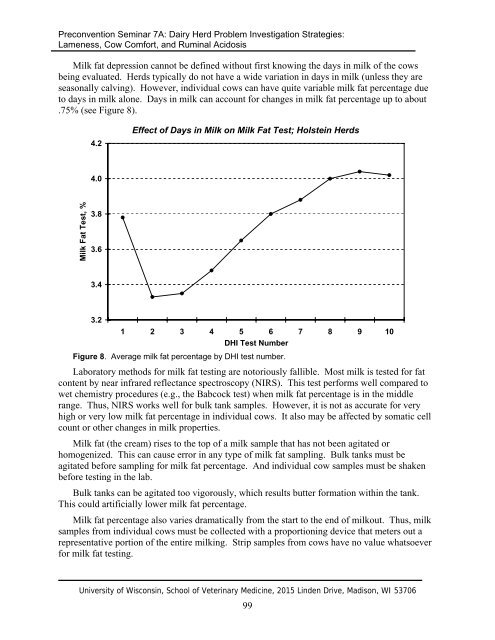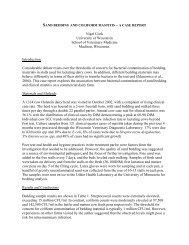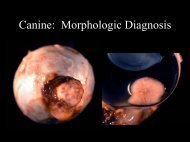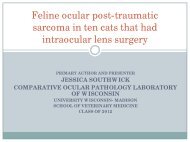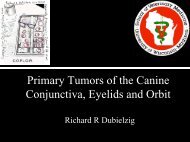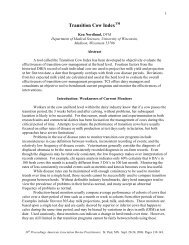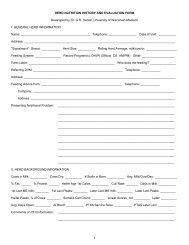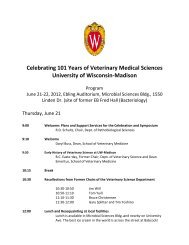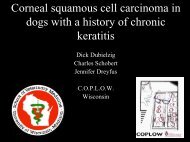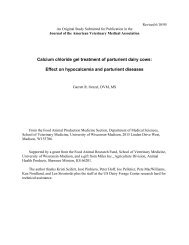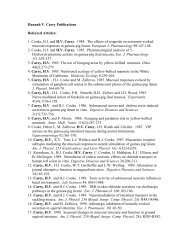Subacute Ruminal Acidosis in Dairy Herds - University of Wisconsin ...
Subacute Ruminal Acidosis in Dairy Herds - University of Wisconsin ...
Subacute Ruminal Acidosis in Dairy Herds - University of Wisconsin ...
Create successful ePaper yourself
Turn your PDF publications into a flip-book with our unique Google optimized e-Paper software.
Preconvention Sem<strong>in</strong>ar 7A: <strong>Dairy</strong> Herd Problem Investigation Strategies:Lameness, Cow Comfort, and <strong>Rum<strong>in</strong>al</strong> <strong>Acidosis</strong>Milk fat depression cannot be def<strong>in</strong>ed without first know<strong>in</strong>g the days <strong>in</strong> milk <strong>of</strong> the cowsbe<strong>in</strong>g evaluated. <strong>Herds</strong> typically do not have a wide variation <strong>in</strong> days <strong>in</strong> milk (unless they areseasonally calv<strong>in</strong>g). However, <strong>in</strong>dividual cows can have quite variable milk fat percentage dueto days <strong>in</strong> milk alone. Days <strong>in</strong> milk can account for changes <strong>in</strong> milk fat percentage up to about.75% (see Figure 8).4.2Effect <strong>of</strong> Days <strong>in</strong> Milk on Milk Fat Test; Holste<strong>in</strong> <strong>Herds</strong>4.0Milk Fat Test, %3.83.63.43.21 2 3 4 5 6 7 8 9 10DHI Test NumberFigure 8. Average milk fat percentage by DHI test number.Laboratory methods for milk fat test<strong>in</strong>g are notoriously fallible. Most milk is tested for fatcontent by near <strong>in</strong>frared reflectance spectroscopy (NIRS). This test performs well compared towet chemistry procedures (e.g., the Babcock test) when milk fat percentage is <strong>in</strong> the middlerange. Thus, NIRS works well for bulk tank samples. However, it is not as accurate for veryhigh or very low milk fat percentage <strong>in</strong> <strong>in</strong>dividual cows. It also may be affected by somatic cellcount or other changes <strong>in</strong> milk properties.Milk fat (the cream) rises to the top <strong>of</strong> a milk sample that has not been agitated orhomogenized. This can cause error <strong>in</strong> any type <strong>of</strong> milk fat sampl<strong>in</strong>g. Bulk tanks must beagitated before sampl<strong>in</strong>g for milk fat percentage. And <strong>in</strong>dividual cow samples must be shakenbefore test<strong>in</strong>g <strong>in</strong> the lab.Bulk tanks can be agitated too vigorously, which results butter formation with<strong>in</strong> the tank.This could artificially lower milk fat percentage.Milk fat percentage also varies dramatically from the start to the end <strong>of</strong> milkout. Thus, milksamples from <strong>in</strong>dividual cows must be collected with a proportion<strong>in</strong>g device that meters out arepresentative portion <strong>of</strong> the entire milk<strong>in</strong>g. Strip samples from cows have no value whatsoeverfor milk fat test<strong>in</strong>g.<strong>University</strong> <strong>of</strong> Wiscons<strong>in</strong>, School <strong>of</strong> Veter<strong>in</strong>ary Medic<strong>in</strong>e, 2015 L<strong>in</strong>den Drive, Madison, WI 5370699


